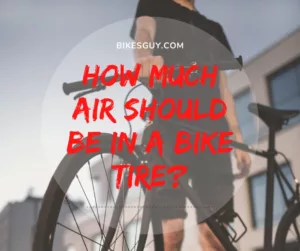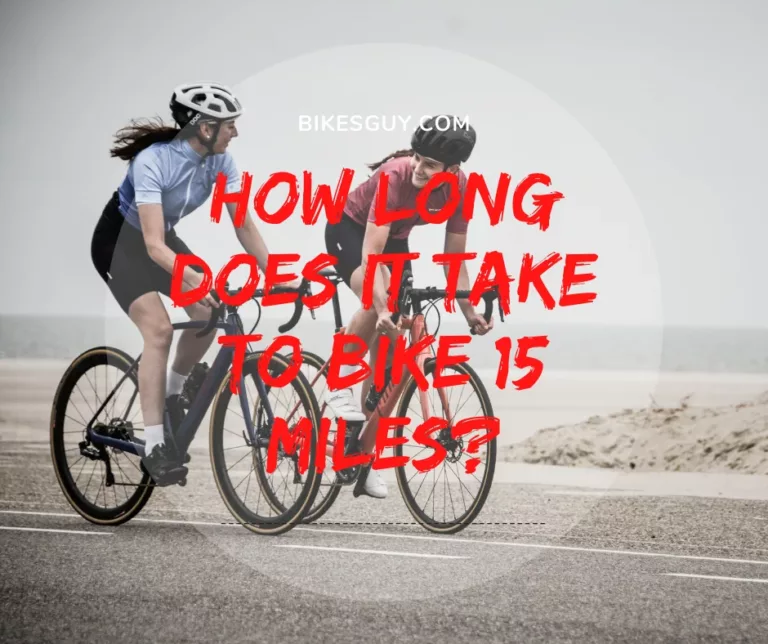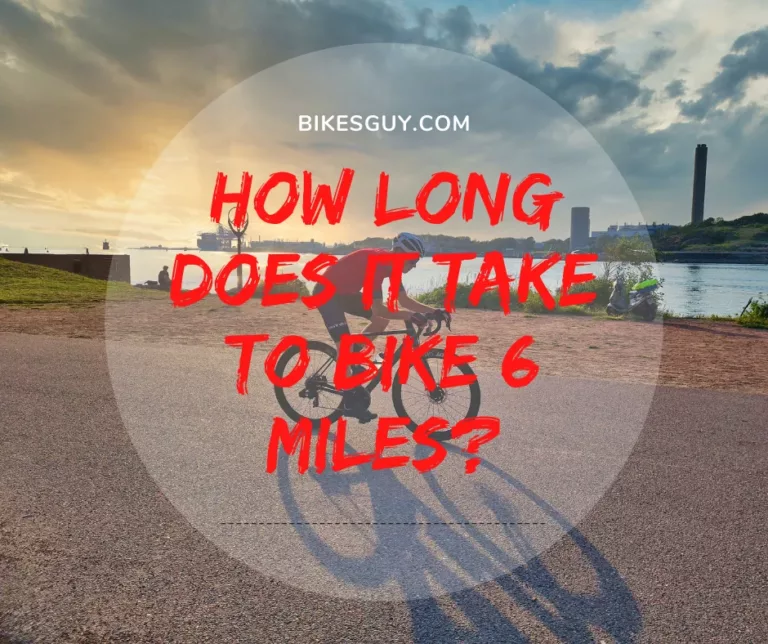How Much Air Should Be in A Bike Tire?
 One of the biggest performance improvements that you can do on your bike isn’t done by getting a fancy set of wheels but is entirely dependent upon tire pressure. Most people think that having lighter wheels or fancy electronics will help them in getting better performance.
One of the biggest performance improvements that you can do on your bike isn’t done by getting a fancy set of wheels but is entirely dependent upon tire pressure. Most people think that having lighter wheels or fancy electronics will help them in getting better performance.
While this also stands true but sometimes it can cost quite a lot of money. The improvement that we are talking about doesn’t cost a lot and will help you in achieving much better performance.
The most common question by a lot of beginners is that how much air should be in a bike tire? There is not a direct answer to this question as it varies due to different factors.
A lot of people don’t pay attention to the air pressure in their bike’s tires and due to this, their bicycles become prone to having more flat tires and also performing much worse.
Contents
- 1 Finding the Ideal Pressure:
- 2 Tire Pressure Adjustment:
- 3 Frequently Asked Questions(FAQ’s)
- 3.1 How do you know how much air to put in bike tires?
- 3.2 What is the air pressure for a 26-inch bike tire?
- 3.3 Where is the PSI on a bike tire?
- 3.4 What happens if you put too much air in your bike tires?
- 3.5 Can I put air in my bike tires at a gas station?
- 3.6 Is 40 psi too high for tires?
- 3.7 Is 26 tire pressure too low?
- 4 Conclusion:
Finding the Ideal Pressure:
If your bike already has the ideal pressure, it will help the bicycle roll quickly and smoothly. You will have a much better riding experience if there is the correct air pressure in the tires. Finding the ideal pressure is really important and also varies with different types of tires and the bodyweight of the person riding the bike.
If you are riding a bicycle with narrow tires then you will need more pressure than you would with a bike with wide tires. Generally, the following air pressure is optimal:
- 80 – 130 psi for Road Bikes
- 25 – 35 psi for Mountain Bikes
- 40 – 70 psi for Hybrid Bikes
For finding the ideal pressure for yourself, you should start right in between these ranges and also factor in your body weight as well. The more you weigh, the higher the tire pressure. As an example, a 200-pound person shouldn’t ride a bike with a tire pressure of 80 psi. There will be a severe loss in performance. But if you weigh around 120-pounds, then you can easily get away with a tire pressure of 80 psi as well.
Checking Tire Pressure Regularly:
You should always keep in mind that tires lose air over time. If you have good tubeless tires or ones with butyl tubes then you will get longer-lasting air pressure. These types of tires leak much less than the latex tubes. But you can’t completely prevent air from leaking from a tire. Some tires can lose just a few psi while others can lose a lot just overnight.
Outside temperature also plays an important role as temperature decreases, the pressure starts to decrease as well. You should make your habit of checking the tire pressure of your bicycle. Regular checkups are necessary. And if you have used a CO2 canister to repair a flat then you should absolutely check the air pressure a day after. Carbon Dioxide can quickly leak through the tire as it is highly soluble in butyl rubber. So, you should always check the pressure after filling the tire with CO2.
The Sweet Spot:
Tire pressure isn’t a thing that you set and forget about it. You always have to check it regularly. If the tire has a higher air pressure then there will be lower rolling resistance. But no road is perfectly smooth so if the tire is inflated perfectly then it will absorb the bumps and shocks thus providing a better riding experience. On the other hand, if you have too much air in your tire, then all of the bumps and shocks will be transmitted directly to the rider thus worsening the ride.
If you are riding on a pavement that is new then your tires will feel really good even at 100 psi but this can’t be said for rough roads. The same goes for wet surfaces, where you should run 10 psi less than normal as it will help you in getting better traction with the road. So, there is a slight difference in the tire pressure according to the conditions. As a result, the sweet spot can be a bit different in varying conditions.
Never Overinflate:
A lot of people think that it is best if they overinflate their tires. Well, this is not the case as more is not always better. If you take into consideration all of the things like the size of the rider, terrain, you will naturally want to have a lower tire pressure. You get a lot more rolling resistance due to the lower tire pressure but various studies show that the increase in rolling resistance is very minimum. The thing that makes the biggest difference in rolling resistance isn’t the pressure itself but the tires that you use. So, you should never overinflate your bike tires.
Tire Pressure Adjustment:
If you are using a road bike then you should use the following table for the adjustment of tire pressure:
| Width of Tire | Volume Difference to Baseline | Sample Pressure |
|---|---|---|
700x23mm | Null | 100 psi |
700x25mm | 15% | 85 psi |
700x28mm | 33% | 65 – 70 psi |
On the other hand, if you are using a mountain bike then the following table should be followed:
| Width of Tire | Volume Difference to Baseline | Sample Pressure |
|---|---|---|
29×2.1 in | Null | 30 psi |
29×2.3 in | 18% | 24.6 psi |
27.5×2.8 in | 41% | 17.7 psi |
However, you should keep in mind that these samples should be taken only as a guideline. If you are using tubeless tires then you can scale these down much further with a difference of 10 to 20%.
Be Cautious of Floor Pumps:
If you are using a floor pump to inflate your tires then you should be really careful as the gauge is not that accurate most of the time. In-floor pumps, the gauge is measuring the pressure at the gauge itself not the air pressure of the tires. Depending on the quality of the gauge, the pressure can be off from a few psi to as high as 15 psi.
One of the better things about these gauges is that they are very consistent in their readings if not accurate. If you use them to inflate your tires then you will exactly fill the tires to the exact pressure every time. You can also buy a Presta gauge which will help you in solving this problem as it is accurate and durable as well.
Testing Different Tire Pressures:
It is a very common practice to generally fill up both the front and rear tires equally. But in the case of bicycles, it is not a general rule as weight balance isn’t always balanced between the tires. In most cases, there is less weight on the front tires say like 40% while the rest of the 60% is on the rear tires. So whichever type of pressure you choose depends upon your riding style and the tires as well. But this is a clear indication that you shouldn’t just run 50-50 on the front and rear.
You should experiment with the tire pressure. For example, if you weigh 200 pounds, then with a weight distribution of 40-60, 120 pounds of your weight is on the back while 80 pounds on the front. So you should be running higher pressure on the back tires and lower pressure on the front tire in order to get the best performance.
The best practice would be to experiment with the tire pressure by taking off 5% of pressure from the front and rear tires and then going for a ride. Do this until you feel very comfortable. If you feel that you are having trouble in cornering then you can add some pressure back in the front tire. But you should keep in mind that the perfect tire always keeps changing depending upon the weather conditions, terrain, and tire size.
[su_divider top=”no” divider_color=”#ff0000″]
Frequently Asked Questions(FAQ’s)
How do you know how much air to put in bike tires?
You can a tire pressure gauge to check the air pressure of the tires. If it’s below the recommended tire pressure, then you can fill it up accordingly.
What is the air pressure for a 26-inch bike tire?
The air pressure for a 26-inch bike tire is somewhere around 30 to 50 psi.
Where is the PSI on a bike tire?
The psi is printed on the side of the tire close to where it is touching the rim. It is generally written as a range.
What happens if you put too much air in your bike tires?
If you put too much air in your bike tires then you will feel all of the bumps and shocks thus making your ride very uncomfortable.
Can I put air in my bike tires at a gas station?
Yes, you can put air in your bike tires at a gas station. But you need to be a bit careful in how you do that. So, you should be careful not to overinflate your tire.
Is 40 psi too high for tires?
40 psi is a bit high in the case of mountain tires but not for hybrid tires. On the other hand, it is way too low for road tires.
Is 26 tire pressure too low?
26 tire pressure is enough for mountain tires but is not sufficient for road and hybrid tires.
[su_divider top=”no” divider_color=”#ff0000″]
Conclusion:
So, with proper tire pressure, you can get a massive boost to your bike’s performance. You should also make it a habit to regularly check your bike’s tire pressure so that you don’t get any kind of trouble on the road. As to how much air should be in a bike tire, it totally depends upon the type of tire, weather conditions, road, etc. It can vary quite a bit depending upon these factors. So, the best thing that you can do is to start off with the manufacturer’s recommended value and then find the sweet spot where you feel the bike is performing the best.






